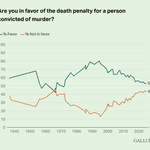DPI Report: Smart on Crime
Reconsidering the Death Penalty in Time of Economic Crisis
Overview
In a democracy, the substance of the laws is determined by the people. Even the constitution can be changed through the democratic process. Public sentiment can be measured through polling, but it is also reflected in elections and referenda, both on a local and national level.
There is a long history of polls of asking the public whether they favor or oppose the death penalty for the crime of murder. The resultant responses might reflect the public’s philosophical or moral stance on the issue, but they do not measure opinion about the death penalty as it is actually practiced, which requires such information as the availability of alternative sentences, the risks of mistake and bias, and the costs associated with the practice.
At Issue
The death penalty is sometimes justified because the majority of poll respondents supports it in the abstract. The Supreme Court, in attempting to determine whether a punishment is cruel and unusual, asks whether the punishment comports with society’s “evolving standards of decency.” The Court has been reluctant to rely on opinion polls to measure these standards because poll results can vary widely depending on the polling firm and the specific wording of the questions asked. Instead, the Court has looked to the actions of state legislatures and the decisions of juries, prosecutors and governors, as reflecting public will. The myriad of disturbing facts about the death penalty has led to a sharp decline in its use and even to a lowering of support in the abstract poll question. Ultimately, the future of the death penalty will depend on whether it is retaining public support.
What DPI Offers
DPI has highlighted the results of many polls on the death penalty over many years, both on a national and state level. Some of these polls go into greater depth than those just asking the abstract question of support or opposition. DPI has also commissioned its own polls, including surveys of those in law enforcement, and has issued reports on the results.

News & Developments
News
Jan 29, 2025
12:01: The Death Penalty in Context — The Death Penalty in 2024
In this month’s episode of 12:01: The Death Penalty in Context, Managing Director Anne Holsinger speaks with DPI Communications Associate Hayley Bedard, about The Death Penalty in 2024, which highlights trends and events related to the death penalty. 2024 marked the tenth consecutive year during which fewer than 30 people were executed (25) and fewer than 50 people were sentenced to death (26), while high profile cases of death-sentenced people attracted…
Read MoreNews
Nov 18, 2024
NEW POLL: Overall Support for the Death Penalty Remains at Five-Decade Low as Opposition to the Death Penalty Grows Among Younger Generations
According to October 2024 polling produced by Gallup, support for capital punishment remains at a five-decade low in the United States. Overall, Gallup found 53% of Americans in favor of the death penalty, but that number masks considerable differences between older and younger Americans. More than half of young adults aged 18 to 43 now oppose the death penalty. Among those expressing a political affiliation, support for the death penalty fell markedly in all groups…
Read MoreNews
Oct 11, 2024
French and German Embassies Host a Discussion on Innocence and the Death Penalty
On October 11, 2024 the Embassies of France and Germany hosted a discussion on the question of innocence and the death penalty at the residence of the French Ambassador in Washington, D.C. Panelists included Herman Lindsey, a death row exoneree and Executive Director of Witness to Innocence; Vanessa Potkin, Director of Special Litigation at the Innocence Project; and Emmjolee Mendoza Waters, Director of the Death Penalty Abolition Program at Catholic Mobilizing Network. The…
Read MoreNews
Sep 16, 2024
NEW RESOURCE: American Bar Association Reports on Capital Punishment and the State of Criminal Justice 2024
The American Bar Association’s Criminal Justice Section has announced its forthcoming annual report, The State of Criminal Justice 2024, examining the state of the American…
Read MoreNews
Sep 05, 2024
Research Roundup: Revisiting David Baldus’s Study to Examine Modern Day Use of the Death Penalty
DPI’s new series focuses on academic research and articles in the field of capital punishment. This month’s article is“Sacred Victims: Fifty Years of Data on Victim Race and Sex as Predictors of Execution,” in The Journal of Criminal Law and Criminology, co-authored by Professors Scott Phillips (Department of Sociology & Criminology), Justin Marceau, Sam Kamin, and a J.D. program alumna, Nicole King, from the Sturm College of Law at the…
Read More



